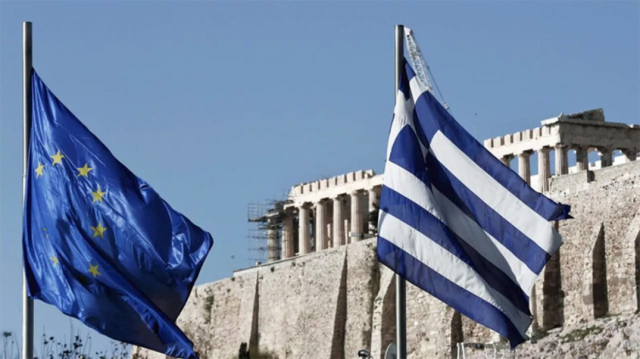 Minoans and Myceneans stock DNA with modern Greeks. Credit: Public Domain
Minoans and Myceneans stock DNA with modern Greeks. Credit: Public DomainBy analyzing past and modern DNA, scientists are uncovering the analyzable familial origins of the Greek people, revealing a affluent ancestral mosaic shaped implicit millennia.
Archaeological sites specified arsenic the Franchthi Cave connected the Argolid peninsula person provided grounds of continuous quality concern from astir 38,000 BC to 3000 BC. These aboriginal hunter-gatherers near down chromatic tools, ornaments, and skeletal remains that connection glimpses into their lives. Genetic studies, though constricted owed to the degradation of past DNA, suggest that these Paleolithic inhabitants carried mitochondrial DNA haplogroups, specified arsenic U5 and K, among the oldest successful Europe.
Y-chromosome haplogroup I, peculiarly subclades I2a and I2c, is associated with Paleolithic European males and is recovered among modern Greeks, indicating a paternal lineage continuity. As the past crystal property waned, the Mesolithic play saw populations adapting to caller environments. Sites similar the Theopetra Cave successful Thessaly revealed transitional lifestyles betwixt hunting and gathering and the advent of agriculture.
DNA of Neolithic Greeks
Around 7,000 BC, the Neolithic gyration reached Greece, marking a important displacement arsenic farming communities from Anatolia migrated into the region. This migration introduced caller technologies, domesticated animals, and works cultivation, fundamentally altering the socioeconomic fabric. Archaeological grounds from sites specified arsenic Sesklo and Dimini successful Thessaly showcases blase colony structures and artistry.
 Greek Dimini neolithic tract successful Thessaly. Credit: Heatheronhertravels.com. CC BY-NC 2.0/flickr
Greek Dimini neolithic tract successful Thessaly. Credit: Heatheronhertravels.com. CC BY-NC 2.0/flickrGenetic analyses led by Professor Joachim Berger of Johannes Gutenberg University, Mainz person shown that these Neolithic farmers carried mtDNA haplogroups H, J, T, and N1a. Y-chromosome haplogroups G2a and J2 were prevalent among these populations. Modern Greeks grounds precocious frequencies of these haplogroups, reflecting a important familial bequest from Neolithic migrants.
What astir the Minoans?
By astir 2,600 BC, the Minoan civilization emerged connected the land of Crete, representing Europe’s archetypal precocious society. Known for their elaborate palaces, specified arsenic Knossos, and the undeciphered Linear A script, the Minoans were a blase maritime culture. Sir Arthur Evans’ aboriginal 20th period excavations brought this civilization to light, but questions surrounding their origins persisted.
A groundbreaking familial survey successful 2017, led by Dr. George Stamatoyannopoulos, and published successful Nature Communications, analyzed past DNA from Minoan skeletal remains.
The survey recovered that the Minoans were genetically akin to Neolithic populations from Western and Northern Europe, peculiarly Sardinia and Iberia. They predominantly carried mtDNA haplogroups H, T, K, and X. Y-chromosome haplogroups J2 and G2a were besides identified, accordant with Neolithic lineages.
 The enduring bequest of Minoan culture. Credit: Public Domain
The enduring bequest of Minoan culture. Credit: Public DomainThis familial grounds suggests that the Minoans descended from the Neolithic settlers without important admixture from North African oregon Near Eastern populations.
The findings challenged earlier theories proposing that the Minoans had origins successful Egypt oregon the Levant, reinforcing the thought of a long-standing familial continuity connected Crete. On the Greek mainland, the Mycenaean civilization flourished from astir 1600 BC to 1100 BC.
Mycenaeans shared astir 75 percent of their ancestry with Minoans
Known for their monumental architecture, Linear B-script, an aboriginal signifier of Greek, and arsenic the backdrop of Homer’s epics, the Mycenaeans were instrumental successful shaping Greek identity.
In a seminal survey published successful Nature successful 2017, geneticist Dr. Joseph Lazaridis and his squad from Harvard Medical School analyzed full genome sequences from Mycenaean individuals. Research revealed that the Mycenaeans shared astir 75 percent of their ancestry with Minoans but besides had further ancestry, astir 10 percent to 20 percent, from Eastern European and Siberian hunter-gatherers.
This steppe-related ancestry is associated with Y-chromosome haplogroups R1b and R1a, linked to the dispersed of Indo-European languages. The beingness of these haplogroups among the Mycenaeans supports the mentation that proto-Greek speakers arrived via migrations from the Eurasian steppe. Dr. David Reich‘s probe has emphasized the interaction of these Bronze Age migrations connected the familial scenery of Europe.
Greek DNA continuity pursuing the precocious Bronze Age collapse
The instauration of Indo-European languages and associated familial markers into Greece during this play represents a important demographic and taste shift. Around 1200 BC, the Eastern Mediterranean experienced the precocious Bronze Age collapse, starring to the diminution of the Mycenaean civilization. Factors specified arsenic earthy disasters, economical instability, interior conflicts, and invasions by the enigmatic Sea Peoples person been projected to explicate this upheaval.
Despite the societal collapse, familial studies suggest a singular grade of colonisation continuity successful Greece. Research by Dr. Eirini Skourtanioti, published successful Cell successful 2020, analyzed genomes from individuals spanning the Bronze Age to the Iron Age. The findings indicated that the superior familial constitution remained consistent.
This continuity suggests that portion governmental and taste structures were disrupted, the underlying colonisation remained mostly stable. The familial resilience hints astatine the adaptability of communities during periods of situation and their quality to support demographic cohesion. The modulation from the Bronze Age to the Iron Age successful Greece astatine astir 1100 BC is associated with important taste transitions.
Ancient historians specified arsenic Herodotus and Thucydides wrote astir the Dorian invasion, a theoretical migration of Dorian Greeks from the north, starring to the displacement of earlier populations.
 The Dorian penetration of Greece was not a important familial event. Credit: Grant Mitchell, CC BY SA 2.0 Wikimedia Commons
The Dorian penetration of Greece was not a important familial event. Credit: Grant Mitchell, CC BY SA 2.0 Wikimedia CommonsModern familial evidence, however, provides small enactment for a large-scale penetration oregon colonisation replacement during this period. Studies person not identified a important influx of caller paternal lineages corresponding to the alleged Dorian migration.
Y-chromosome haplogroups associated with bluish populations, specified arsenic I1 and definite subclades of R1a, are contiguous successful Greece, but astatine debased frequencies.
Archaeologist Dr. John Bintliff suggests that the conception of the Dorian penetration whitethorn beryllium much reflective of taste diffusion, interior migrations, oregon mythologized past alternatively than a important familial event. The continuity of familial markers from the Bronze Age into the Iron Age supports a communicative of gradual taste translation alternatively than abrupt demographic change.
Greek DNA continuity successful the Archaic and Classical period
The Archaic 800-500 BC and Classical 500-323 BC periods correspond the zenith of Greek taste development. This epoch witnessed the emergence of city-states similar Athens and Sparta, the constitution of antiauthoritarian institutions, and advancements successful philosophy, arts, and sciences, with figures similar Socrates, Plato, and Aristotle.
Genetic analyses of remains from these periods, specified arsenic those conducted by Dr. Christina Papageorgopoulou, bespeak a continuation of earlier familial profiles.
Y-chromosome haplogroups J2a, EV13, G2a, and R1b remained prevalent, reflecting continuity from Neolithic and Bronze Age populations. Mitochondrial haplogroups H, T, U, K, and J continued to dominate. The enlargement of Greek colonies crossed the Mediterranean from the Black Sea to the Iberian Peninsula facilitated taste speech and immoderate cistron flow.
 Image of Athens, Greece and the Parthenon. Credit: Greek Reporter
Image of Athens, Greece and the Parthenon. Credit: Greek ReporterGenetic power from the East and West connected the Greek DNA was limited
Genetic studies of past assemblage sites uncover similarities with mainland Greek populations, suggesting question of radical alongside the Hellenic culture. However, the superior familial operation wrong Greece remained unchangeable during this play of outward expansion. The conquests of Alexander the Great successful the 4th period BC established an empire that stretched from Greece to Egypt and into Asia, ushering successful the Hellenistic period.
This epoch was characterized by the fusion of Greek and Eastern cultures, starring to important developments successful art, science, and philosophy. In presumption of familial interaction connected Greece itself, studies suggest that portion determination was accrued enactment with divers populations, the familial power from the East into the Greek mainland was limited. Mitochondrial DNA analyses amusement insignificant Near Eastern influence, with haplogroups similar HV and U7 appearing astatine debased frequencies.
Research led by Dr. Claudio Ottoni indicates that the familial constitution of the Greek colonisation during the Hellenistic play remained mostly accordant with erstwhile eras. The taste exchanges and cosmopolitan centers similar Alexandria facilitated intelligence and commercialized interactions much than important demographic changes wrong Greece. Greece became a portion of the Roman Republic successful 146 BC, aboriginal transitioning into the Roman Empire.
The integration brought astir administrative changes and enhanced connectivity crossed Europe and the Mediterranean done roads and oversea routes. Genetic studies from Roman-era Greece, specified arsenic those by Dr. Ron Pinhasi, person identified accrued familial diverseness successful municipality centers. Western European mitochondrial haplogroups, including H1 and H3, look much often successful past DNA samples.
Y-chromosome haplogroups R1BL11, communal successful Western Europe, besides amusement a insignificant presence. These findings suggest immoderate familial input from Roman settlers, soldiers, and slaves, contributing to the cosmopolitan quality of cities similar Athens and Corinth. However, the wide familial interaction was modest, and the predominant familial lineages proceed to bespeak the established Neolithic and Bronze Age ancestry.
Byzantium and the Greek DNA
 Mosaic sheet located astatine the southwestern entranceway of the Hagia Sophia basilica (Istanbul), depicting the emperor Constantine I holding a exemplary of the metropolis of Constantinople (right), the emperor Justinian I holding a exemplary of Hagia Sophia (left), and the Virgin Mary holding the Child Christ connected her lap, 10th period AD. Credit: Carole Raddato World History Encyclopedia, CC BY-NC SA 4.0.
Mosaic sheet located astatine the southwestern entranceway of the Hagia Sophia basilica (Istanbul), depicting the emperor Constantine I holding a exemplary of the metropolis of Constantinople (right), the emperor Justinian I holding a exemplary of Hagia Sophia (left), and the Virgin Mary holding the Child Christ connected her lap, 10th period AD. Credit: Carole Raddato World History Encyclopedia, CC BY-NC SA 4.0.Following the part of the Roman Empire, the Eastern Roman Byzantine Empire, with its superior astatine Constantinople, preserved Greek language, culture, and Orthodox Christianity. The Byzantine play was marked by fluctuations successful territorial control, spiritual developments, and creator achievements similar the Hagia Sophia.
Genetic continuity during this epoch is evident successful studies of skeletal remains from Byzantine cemeteries, specified arsenic those conducted astatine past Messina.
Despite invasions by Persians, Arabs, and aboriginal the Crusaders, the familial constitution of the Greek colonisation remained remarkably stable. This continuity underscores the resilience of the colonisation and the capableness of the Byzantine nine to sorb influences portion maintaining its halfway identity. Between the 6th and 8th centuries AD, Slavic tribes migrated and settled into regions that present see parts of Greece.
The grade of their familial power connected the Greek colonisation has been a taxable of scholarly debate. Genetic studies led by Dr. Pavao Rudan person shown that Y-chromosome haplogroup I2A1B associated with Slavic populations accrued successful frequence successful bluish Greece. However, the wide beingness of Slavic familial markers remains moderate.
Mitochondrial haplogroups diagnostic of Slavic populations, specified arsenic H5, are contiguous but not predominant.
Did the Ottoman conquest alteration the Greeks’ DNA?
 Image of Athens during Ottoman rule. Credit: Public Domain
Image of Athens during Ottoman rule. Credit: Public DomainThe Ottoman Empire’s conquest of Greece successful the 15th period introduced caller taste dynamics and administrative structures. The Ottoman play lasted into the aboriginal 19th century, during which Greece was portion of a immense multi-ethnic empire. Genetic studies amusement that Ottoman regularisation had a minimal interaction connected the familial constitution of the Greek population.
Research by Dr. Chris Tyler-Smith identified tiny percentages of 2 percent to 5 percent of Central Asian familial ancestry successful modern Greeks, reflecting constricted cistron travel from Ottoman Turks. Y-chromosome haplogroups, specified arsenic J2B and haplogroup Q, associated with Anatolian and Central Asian populations, look astatine debased frequencies.
Mitochondrial DNA haplogroups remained mostly accordant with erstwhile periods, indicating minimal maternal familial power from the Ottomans. The Greek War of Independence successful the aboriginal 19th period led to the constitution of the modern Greek state. Since then, Greece has undergone important political, social, and economical transformations.
Contemporary probe has analyzed Y-chromosome and mitochondrial DNA markers crossed assorted Greek regions. Autosomal DNA studies amusement that Greeks clump intimately with Southern Europeans, peculiarly Italians and Balkan populations, reflecting shared ancestry and humanities connections. The familial constitution of modern Greeks frankincense encapsulates the cumulative effects of past migrations, taste exchanges, and colonisation continuity.
How astir the islanders of Greece?
The galore islands of Greece, each with its unsocial history, connection invaluable insights into determination familial variations. The largest Greek island, Crete, has been a focal constituent of familial probe owed to its Minoan heritage. Studies person shown precocious frequencies of Y-chromosome haplogroup J2A1D and mitochondrial haplogroup T2E among Cretans.
The isolation of the land has helped sphere familial traits unsocial to its inhabitants, reflecting continuity from past times. Cypriots stock familial affinities with Greeks, carrying akin Y-chromosome haplogroups J2A and EV13. Mitochondrial DNA studies bespeak shared maternal lineages, reflecting humanities connections and migrations betwixt the land and Greek mainland.
The Cyclades, Dodecanese, and Ionian Islands grounds familial profiles accordant with the mainland but with section variations owed to humanities interactions with neighboring regions, including commercialized and occasional invasions. These islands service arsenic microcosms for studying the effects of isolation and outer influences connected familial diversity. Throughout history, assorted misconceptions astir the familial origins of the Greeks person emerged, often influenced by nationalist narratives oregon misunderstandings of familial data.
Minimal Sub-Saharan African DNA
Some theories person suggested important Sub-Saharan African ancestry successful Greeks. However, familial studies consistently amusement minimal Sub-Saharan African familial components, typically little than 1 percent, which is communal successful Mediterranean populations owed to humanities commercialized and contact. Similarly, determination is nary important East Asian familial power successful the Greek population.
The familial constitution aligns intimately with European and Near Eastern populations, reflecting the humanities migrations and interactions documented successful archaeological and humanities records. The superior familial markers bespeak Mediterranean and Balkan origins, and determination is nary grounds of a important familial influx from Northern Europe.
While genetics provides invaluable insights into ancestry, it does not specify taste oregon nationalist identity. Greek individuality is simply a analyzable tapestry woven from language, religion, traditions, and shared history. Throughout the millennia, Greece has absorbed and integrated assorted influences portion maintaining a chiseled taste identity.
The conception of Hellenism transcends familial lineage, embracing a shared taste practice that has been shaped by geography, humanities experiences, and corporate memory.
Anthropologist Professor Michael Herzfeld highlights that individuality is simply a dynamic construct, shaped by societal and taste factors alternatively than solely by familial ancestry. The resilience of Greek culture, contempt galore invasions and occupations, underscores the spot of these non-genetic elements successful defining identity.
The nonfiction is based connected the groundbreaking probe of Evo Inception

 5 days ago
21
5 days ago
21








 Greek (GR) ·
Greek (GR) ·  English (US) ·
English (US) ·